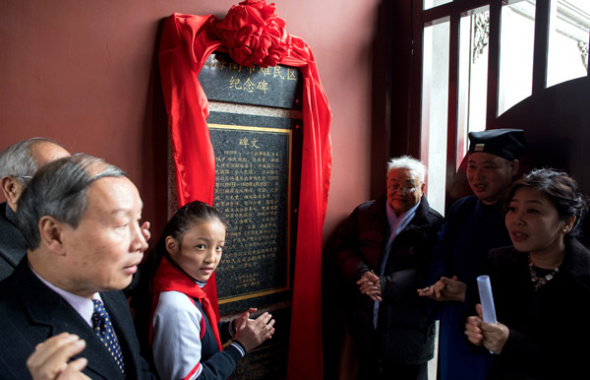
Among those at the ceremony in Shanghai on Thursday unveiling a stone plaque to honor Robert Jacquinot de Besange are (from left) Su Zhiliang, a professor at Shanghai Normal University; a student representative; and representatives of refugees from the time of the Japanese occupation. (Photo by Gao Erqiang/China Daily)
Jacquinot negotiated with Japanese to set up the Shanghai Safety Zone
Just hours after a national day of mourning for the hundreds of thousands of Chinese killed by invading Japanese troops during the Nanjing Massacre, a stone plaque was unveiled in Shanghai on Thursday honoring Robert Jacquinot de Besange for saving hundreds of thousands more. [Special coverage]
Eighty years ago, Jacquinot, a French Jesuit priest, set up the Shanghai Safety Zone in the former Nanshi district as Japanese troops invaded Shanghai that August, displacing a large number of civilians.
"It is the first safety zone set up during the war and it inspired German businessman John Rabe to establish the Nanjing Safety Zone to protect people during the Nanjing Massacre," said Su Zhiliang, who earlier this year published a biography of Jacquinot, Shanghai's Rabe: Rao Jiaju, which was Jacquinot's Chinese name.
After the war broke out in Shanghai, many refugees first sought shelter in the French Concession and the International Settlement, but those areas soon imposed stricter entrance policies that September, as more than 100,000 refugees tried to enter the concessions, said Su, a history professor at Shanghai Normal University.
Serving as the vice-chairman of the Shanghai International Red Cross at the time, Jacquinot wrote letters to then-Shanghai mayor Yu Hongjun, proposing the idea of setting up a demilitarized zone for refugees.
He also negotiated with the Japanese and sought support from the authorities of foreign concessions, and the safety zone was established in November 1937.
Pan Guang, whose father Pan Da used to be Jacquinot's assistant, recalled his father praising Jacquinot as being a man with great foresight, a down-to-earth work ethic and knowledge of how to mediate between different parties.
From 1937 to 1940, around 300,000 refugees found shelter in the 1-million-square-meter area on the northern side of the old Shanghai city center, which is surrounded by today's Renmin Road and Fangbang Middle Road.
The safety zone was then widely known as the "Jacquinot Zone".
The brief history of the safety zone and its founder Jacquinot is now inscribed on the plaque installed on the wall at the southern entrance of the Shanghai City God Temple, which used to be one of the main shelters in the safety zone.
Three former refugees came to see the plaque unveiled. "I could still remember I went to the temple every day to get the daily portion of bread or porridge," Fu Jianqiu, 89, said. "The safety zone helped us survive the war."
Jacquinot also applied his experience in Shanghai to set up similar safety zone in Wuhan, Hubei province, when it was captured by Japanese troops in 1938.
Born in 1878 in the town of Saintes, France, Jacquinot came to China as a missionary in 1913, and spent the following years in the country before returning to France in 1940 when it was under attack by Nazi Germany.
He died of illness in Berlin in 1946 while serving as head of a Vatican delegation to deal with refugee matters after World War II.
Despite his contribution to refugee relief, his name had been relatively unknown to people and his history less studied by scholars.
Liu Qiaolin, a Taoist priest at Shanghai City God Temple, said the temple has served as a refugee shelter four times in history, but he didn't know Jacquinot set up the shelter during the Japanese invasion.
"I have come to the temple many times without knowing Father Jacquinot," said Delphine Lignieres, a French foreign trade adviser who has lived in the city for 15 years.
"Father Jacquinot is not very known to the public in France, either. I learned of his deed today. It's very touching and I think he deserves more recognition."
Jin Ya, member of a documentary project on Jacquinot and the safety zone, said her team had been gathering video and audio material for two years.
"We have filmed 40 people related to the safety zone," Jin said. "Those who were children during that time are now already in their 80s and 90s. We should find them before it's too late."


















































